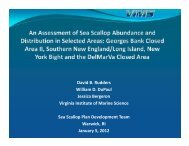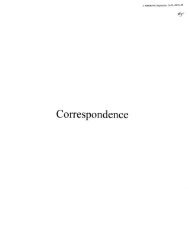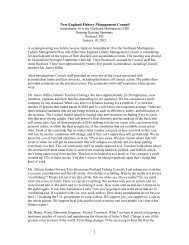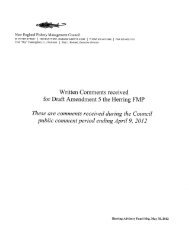Smooth Bottom Net Trawl Fishing Gear Effect on - New England ...
Smooth Bottom Net Trawl Fishing Gear Effect on - New England ...
Smooth Bottom Net Trawl Fishing Gear Effect on - New England ...
You also want an ePaper? Increase the reach of your titles
YUMPU automatically turns print PDFs into web optimized ePapers that Google loves.
NOAA/NMFS Unallied Science Project, Cooperative Agreement NA16FL2264 December 2005<br />
<str<strong>on</strong>g>Smooth</str<strong>on</strong>g> <str<strong>on</strong>g>Bottom</str<strong>on</strong>g> <str<strong>on</strong>g>Net</str<strong>on</strong>g> <str<strong>on</strong>g>Trawl</str<strong>on</strong>g> <str<strong>on</strong>g>Fishing</str<strong>on</strong>g> <str<strong>on</strong>g>Gear</str<strong>on</strong>g> <str<strong>on</strong>g>Effect</str<strong>on</strong>g> <strong>on</strong> the Seabed:<br />
Investigati<strong>on</strong> of Temporal and Cumulative <str<strong>on</strong>g>Effect</str<strong>on</strong>g>s BKAM/CR<br />
collected footage obtained from the video-sled operated in a drift mode. The 2002 data is most<br />
comparable to the ROV data from 2001. Both techniques utilized a cross lane survey design at<br />
specific points al<strong>on</strong>g the experimental and c<strong>on</strong>trol lanes. In c<strong>on</strong>trast the towed video-sled was<br />
run al<strong>on</strong>g the entire length of the lanes. Additi<strong>on</strong>ally, the towed video-sled moved relatively fast<br />
(1 to 2 knots) al<strong>on</strong>g the sea floor and hence would “image” a greater proporti<strong>on</strong> of fish that show<br />
avoidance behavior such as silver hake and flounder. In c<strong>on</strong>trast, the ROV and drift video-sled<br />
move al<strong>on</strong>g the bottom much more slowly and would tend to “image” more sedentary fish, such<br />
as ocean pout and red hake.<br />
The most direct comparis<strong>on</strong> that can be made between the 2001 and 2002 data is between the<br />
2001 pre-trawl ROV data and the July 2002 data (Table 3.3-5). In 2001, twice as many fish were<br />
seen in Mud Hole (0.35±0.30 and 0.46±0.12 individuals per minute) than in Little Tow<br />
(0.25±0.13 and 0.27±0.21 individuals per minute). In c<strong>on</strong>trast, fish were present in almost equal<br />
densities in the two areas in July 2002, with fish ranging from 0.47±0.45 to 0.68±0.26<br />
individuals per minute in Mud Hole and from 0.74±0.36 to 0.72±0.19 individuals per minute in<br />
Little Tow. Additi<strong>on</strong>ally, the faunal compositi<strong>on</strong> of fish was slightly different am<strong>on</strong>g the years.<br />
In 2001, red hake were an important part of the fauna in Mud Hole, whereas they were not<br />
present in July 2002. In c<strong>on</strong>trast, flounder were a relatively small proporti<strong>on</strong> of the fish seen in<br />
Mud Hole in 2001, and a major proporti<strong>on</strong> of the fish seen in July 2002. At Little Tow, sculpin<br />
and ocean pout were both major comp<strong>on</strong>ents of the fish seen in 2001, while <strong>on</strong>ly sculpin were an<br />
appreciable proporti<strong>on</strong> of the fish seen in Little Tow in July 2002. Part of these differences may<br />
be partially related to differences between the survey techniques. The ROV probably moved<br />
across the sea floor more slowly than the drift video-sled and may also have created more of a<br />
disturbance. This would tend to scare fish with str<strong>on</strong>g avoidance behavior, and thus under<br />
represent them. However, visibility was also much lower in 2002 than in 2001 and the video-sled<br />
would have needed to be very close to a fish to successfully “image” it.<br />
Overall invertebrate densities were comparable between the two years (Table 3.3-5). Sea stars<br />
were the dominant invertebrates seen during both years. However, the high abundance of shrimp<br />
noted in 2002 was not evident in 2001. Again, this discrepancy may be related to differences<br />
between the survey techniques. Due to the very poor visibility encountered in 2002, the videosled<br />
was run very close to the sea floor making it possible to “image” organisms that might not<br />
have been seen if the camera was slightly further away (as may have been the case in 2001).<br />
Several similarities between the two years were noted. In both years, sea stars were less abundant<br />
in the northern part of Mud Hole (Stati<strong>on</strong>s 1B and 2B) than in the southern part. Additi<strong>on</strong>ally,<br />
sand dollars were also important, yet patchily distributed inhabitants of the sand waves found in<br />
the southern regi<strong>on</strong> of Little Tow during both years (see Plates 3.3-14, 3.3-15 and 3.3-16).<br />
42







